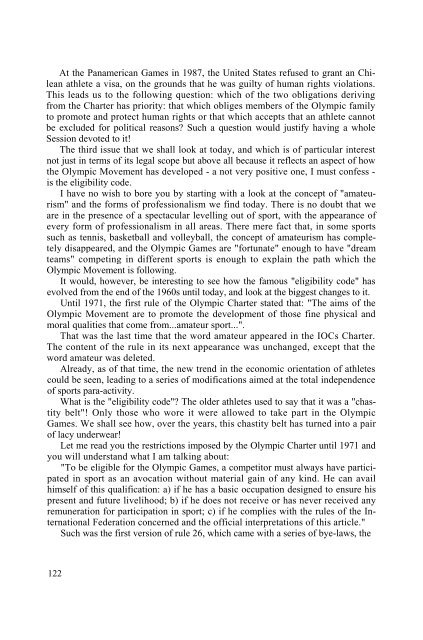You also want an ePaper? Increase the reach of your titles
YUMPU automatically turns print PDFs into web optimized ePapers that Google loves.
At the Panamerican Games in 1987, the United States refused to grant an Chilean<br />
athlete a visa, on the grounds that he was guilty of human rights violations.<br />
This leads us to the following question: which of the two obligations deriving<br />
from the Charter has priority: that which obliges members of the Olympic family<br />
to promote and protect human rights or that which accepts that an athlete cannot<br />
be excluded for political reasons? Such a question would justify having a whole<br />
Session devoted to it!<br />
The third issue that we shall look at today, and which is of particular interest<br />
not just in terms of its legal scope but above all because it reflects an aspect of how<br />
the Olympic Movement has developed - a not very positive one, I must confess -<br />
is the eligibility code.<br />
I have no wish to bore you by starting with a look at the concept of "amateurism"<br />
and the forms of professionalism we find today. There is no doubt that we<br />
are in the presence of a spectacular levelling out of sport, with the appearance of<br />
every form of professionalism in all areas. There mere fact that, in some sports<br />
such as tennis, basketball and volleyball, the concept of amateurism has completely<br />
disappeared, and the Olympic Games are "fortunate" enough to have "dream<br />
teams" competing in different sports is enough to explain the path which the<br />
Olympic Movement is following.<br />
It would, however, be interesting to see how the famous "eligibility code" has<br />
evolved from the end of the 1960s until today, and look at the biggest changes to it.<br />
Until 1971, the first rule of the Olympic Charter stated that: "The aims of the<br />
Olympic Movement are to promote the development of those fine physical and<br />
moral qualities that come from...amateur sport...".<br />
That was the last time that the word amateur appeared in the IOCs Charter.<br />
The content of the rule in its next appearance was unchanged, except that the<br />
word amateur was deleted.<br />
Already, as of that time, the new trend in the economic orientation of athletes<br />
could be seen, leading to a series of modifications aimed at the total independence<br />
of sports para-activity.<br />
What is the "eligibility code"? The older athletes used to say that it was a "chastity<br />
belt"! Only those who wore it were allowed to take part in the Olympic<br />
Games. We shall see how, over the years, this chastity belt has turned into a pair<br />
of lacy underwear!<br />
Let me read you the restrictions imposed by the Olympic Charter until 1971 and<br />
you will understand what I am talking about:<br />
"To be eligible for the Olympic Games, a competitor must always have participated<br />
in sport as an avocation without material gain of any kind. He can avail<br />
himself of this qualification: a) if he has a basic occupation designed to ensure his<br />
present and future livelihood; b) if he does not receive or has never received any<br />
remuneration for participation in sport; c) if he complies with the rules of the International<br />
Federation concerned and the official interpretations of this article."<br />
Such was the first version of rule 26, which came with a series of bye-laws, the<br />
122

















